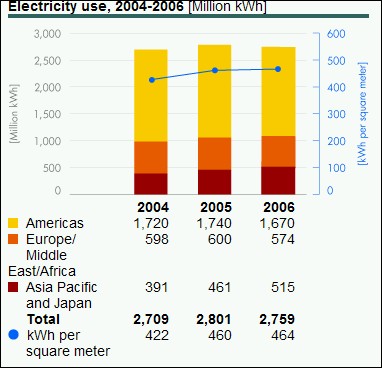HP: Energy Use
From Lauraibm
Contents |
MI Summary
Energy use accounts for 97% of HP’s Greenhouse Gas emissions from operations. During 2006 energy use decreased by 1% saving 42 million kWh. This was primarily achieved through the site consolidation program, which involves consolidating operational locations to core sites. These updated sites use the latest energy efficient HP technology, in addition to this networked printers are installed which use less energy than desk side models and have the added benefit of reducing paper consumption by 10%.
In addition, Static Smart Cooling technology has been implemented in many of HP’s data centres, this contributes to reducing energy consumption by an average of 8.7%.
Text of Article
Energy use accounts for 97% of HP's greenhouse gas (GHG) emissions from operations. During 2006, energy use decreased 1% while energy costs increased by more than 13%. Energy is one of the largest costs of operating our buildings, and energy efficiency is a company-wide priority. We continually identify and implement energy saving initiatives to reduce energy consumption and costs.
In May 2006, we announced HP Workplace Transformation, an initiative to consolidate our operational locations to core sites. As part of this program, we set a goal to reduce our energy use at HP owned and HP leased sites worldwide by 15% by 2010. We will achieve this reduction by upgrading building infrastructure and reducing total floorspace.
The upgraded sites will use the latest energy efficient HP technology. For example, updating cathode ray tube (CRT) monitors with flat panel displays would reduce energy use by more than 4 million kWh/year, which equals approximately 2,000 tonnes CO2 or about $320,0001 in annual savings. We are also installing networked printers throughout our facilities, which use less energy than desk-side models, and have demonstrated a 10% reduction in paper consumption.
We have already implemented HP's Static Smart Cooling technology into many of our data centers, reducing energy consumption on average by 8.7%. In May 2006, we announced plans to consolidate 85 data centers in 29 countries into six data centers in three U.S. locations. These data centers will incorporate our second generation of Smart Cooling technology, HP Dynamic Smart Cooling (DSC) (see case study). This technology enables real-time changes to air conditioners, fans, vents and even computing, and it is anticipated to reduce our data center energy consumption related to cooling by 15% to 40%.
2006 energy audits
HP's energy goal for 2006 was to conduct energy audits at 53 of our largest facilities and implement measurable energy efficiency projects at each one. Eight of the planned audits were cancelled due to consolidation plans. We completed the remaining 45 audits, which have currently yielded projects resulting in energy savings of approximately 27 million kWh/year ($1.9 million). A few sites are still in the process of implementing projects.
Electricity Use
HP measures electricity consumption in absolute use (million kWh) and normalized per unit of floor space (kWh/square meter). Electricity use during 2006 decreased by 1% compared to 2005, saving 42 million kWh. We achieved this primarily through our site consolidation program.
Renewable Energy
HP continues to increase renewable electricity use by purchasing electricity from third parties and installing solar systems at two of our facilities.
In 2006, we purchased 11 million kWh of renewable energy. In December 2006, we joined the U.S. Environmental Protection Agency's (EPA) Green Power Purchase program and are participating in their challenge to Fortune 500 companies to double their renewable energy purchases by the end of 2007. We plan to increase our renewable energy purchases by more than 350% by procuring 50 million kWh of renewable electricity during 2007.
(14)
Source
- 14. Energy Use

